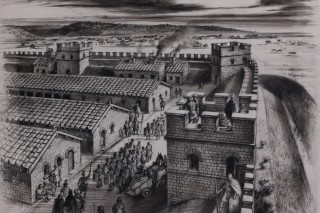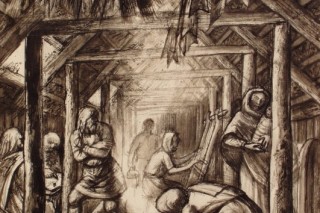Dr Paul Roberts, Sackler Keeper of Antiquities, writes: The Ashmolean Museum is very grateful to the Friends of the National Libraries, for its generous grant towards the purchase of the Alan Sorrell Publication Archive.
This remarkable resource comprises 265 book illustrations (from volumes including Imperial Rome, Prehistoric Britain, Norman Britain and illustrations for an edition of the Holy Bible), 195 working drawings,102 sketches, 38 sketchbooks, 34 diaries and 80 letters. The archive is multi- and inter-disciplinary, traversing archaeology, art, and the historiography of the archaeological discipline. Sorrell trained formally at the Royal Academy of Art, but it was his two years at the British School at Rome, surrounded by the city’s art, architecture and archaeology and fellow students in all these disciplines and more, that were so formative for his career. From the 1930s to the mid-1970s, Sorrell’s evocative and pioneering illustrations, usually the product of extensive research and conversations between Sorrell, excavators and other specialists, were central to archaeological research and dissemination. His view of the past shaped the perception of generations of scholars and public alike and, helped inspire many (like me!) to enter the field.
The archive still has huge relevance and resonance today, seen very well against the backdrop of the wide-ranging collections at the Ashmolean Museum. In the Department of Antiquities, Sorrell’s illustrations are pertinent to holdings from Roman Britain, Imperial Rome, Anglo-Saxon and Medieval England, ancient Greece, the ancient Near East, and ancient Egypt and Sudan. In the context of the Department of Western Art, the Sorrell archive underlines how contemporary artists, including John Piper and Henry Moore, were influenced by contemporary depictions of historic landscapes, ruins, and heritage. The archive also supplements and complements very important excavation archives including those of Sir Arthur Evans and E.T. Leeds, as well as two other graphic archives, namely the facsimiles of ancient Egyptian tomb scenes made by Nina Davies and the reconstructions by Piet de Jong of Greek sites, including Knossos.
Sorrell’s illustrations, diaries and correspondence provide a window into the collaborative creative process between Sorrell and principal British archaeologists of the 20th century, and illuminates the development of archaeological illustration into a discipline in its own right. Sorrell’s work, in combination with our archives, our collections, and archives elsewhere in the University of Oxford (the Institute of Archaeology and the Griffith Institute) will be key to any future study on the historiography of archaeological illustration, reconstruction and interpretation. The University of Oxford was, and is, a centre of disciplinary development in archaeology, so the Ashmolean Museum is a natural home for such an archive.
We wish to share this archive as widely as possible. The physical material will be freely available to all through display (in line with Conservation best practice) in permanent galleries, through facilitated access in our Von Bothmer Study Centre, or through loans to temporary national and international exhibitions. The extension of digitisation and the provision of images, professionally supplied by our Picture Library, will widen access still further and create essential tools for long-term public access to this unique and valuable archive. Huge gratitude is owed to FNL for helping to make all of this a possibility.


